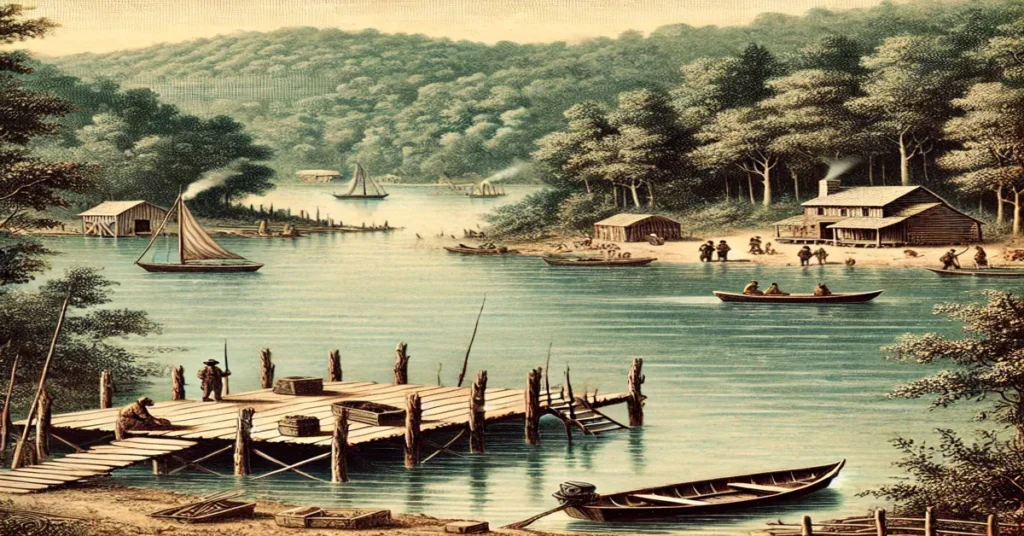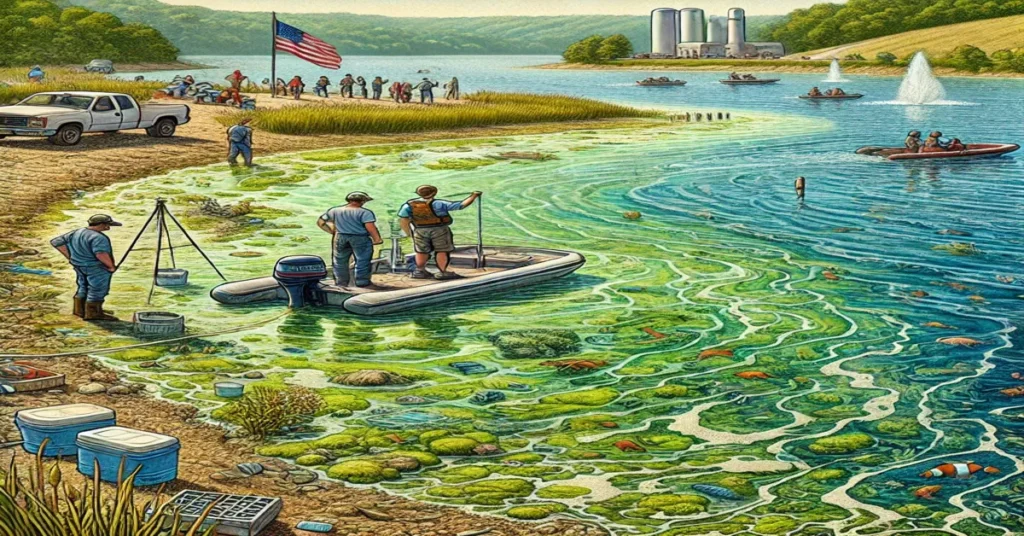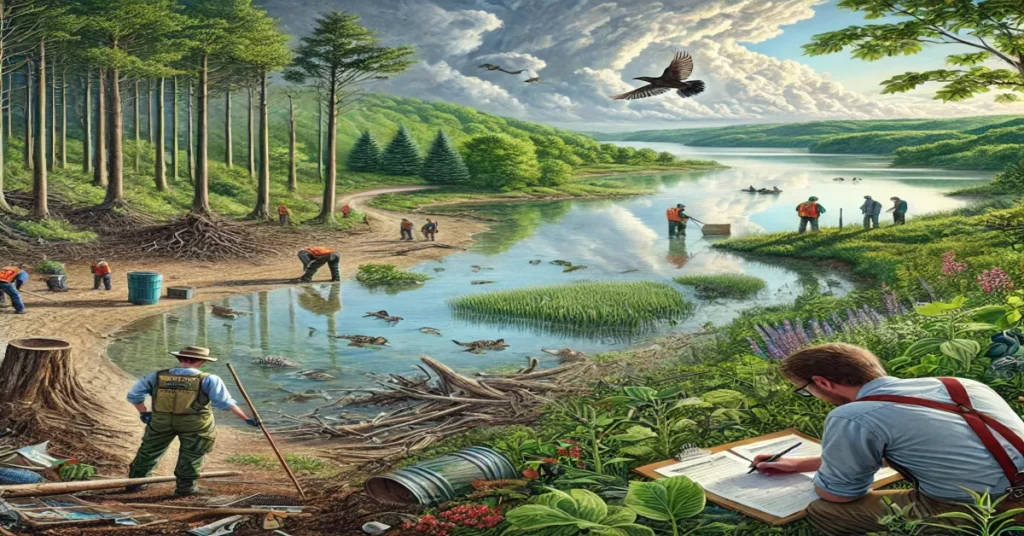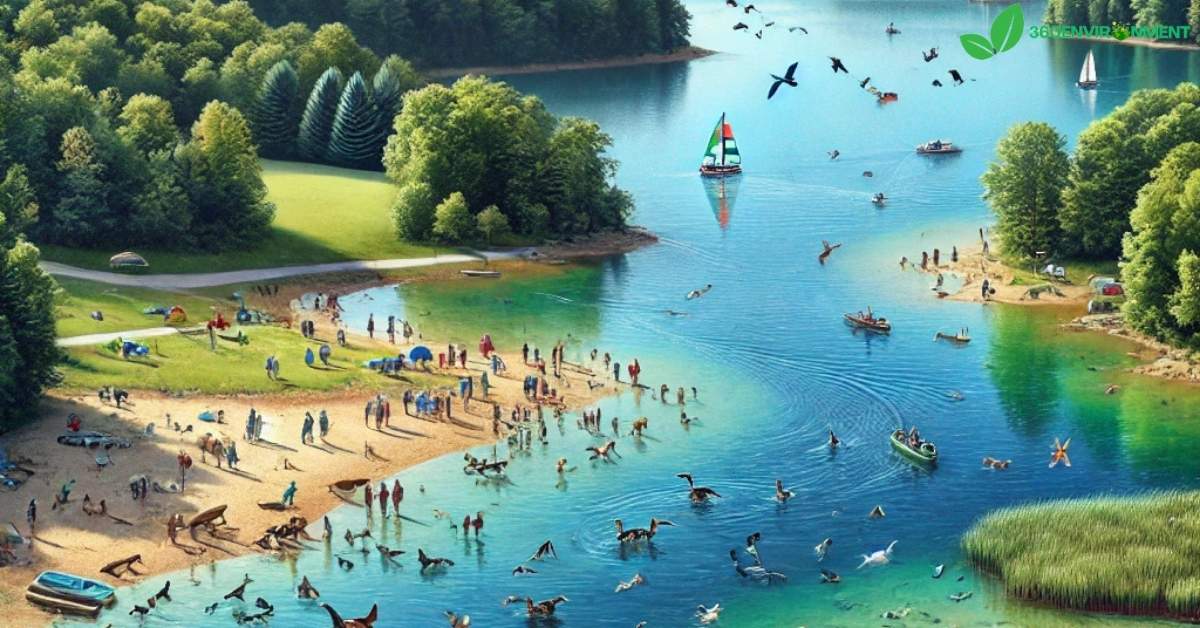Sweetwater Lake, located in Brown County, Indiana, is a pristine example of a man-made reservoir that has become a beloved destination for nature lovers, outdoor enthusiasts, and environmentalists alike. Surrounded by rolling hills, dense forests, and a thriving ecosystem, Sweetwater Lake Indiana offers a rare blend of recreational opportunities and environmental importance. This small but significant lake has become a focal point for local conservation efforts, supporting a wide range of species while providing a peaceful retreat for visitors.
In this article, we will explore the environmental importance of Sweetwater Lake, the diverse species it supports, the recreational opportunities it offers, and the ongoing efforts to maintain its ecological health. Through a deep dive into the history, ecosystem, and conservation challenges of Sweetwater Lake, we’ll discover why this lake is more than just a picturesque body of water—it’s a critical component of Indiana’s natural landscape.
1. History of Sweetwater Lake Indiana
Sweetwater Lake, along with nearby Cordry Lake, is a man-made reservoir created in the early 1960s. These lakes were designed as part of a housing development project spearheaded by the Cordry Sweetwater Conservancy District. The goal was to create a recreational lake community where residents could enjoy water-based activities while surrounded by nature.

1.1. Formation and Development of Sweetwater Lake Indiana
The lake was formed by damming Sweetwater Creek, a tributary of the East Fork of the White River. With a surface area of 260 acres and a maximum depth of approximately 60 feet, Sweetwater Lake quickly became a hub for recreation and a home to a variety of fish and wildlife. The surrounding community, composed primarily of private homes and cottages, was developed with the goal of preserving the natural beauty of the area while providing a tranquil escape for residents.
1.2. Role of the Cordry Sweetwater Conservancy District
The Cordry Sweetwater Conservancy District (CSCD) plays a crucial role in the management of Sweetwater Lake. Established in 1966, the CSCD is responsible for maintaining the lake’s water quality, managing the surrounding watershed, and overseeing infrastructure improvements. This level of management ensures that the lake remains a clean, healthy environment for both wildlife and human activity, contributing to its long-term sustainability.
2. Ecosystem and Biodiversity of Sweetwater Lake Indiana
Sweetwater Lake Indiana is not only a recreational gem but also a critical habitat for a variety of species. Its unique combination of aquatic, terrestrial, and riparian environments makes it a hotspot for biodiversity in central Indiana. This section will explore the various ecosystems around the lake and the species that depend on it.

2.1. Aquatic Life
The waters of Sweetwater Lake Indiana support a variety of fish species, making it a popular spot for anglers. Some of the most common species found in the lake include:
- Largemouth bass: A favorite among anglers, these predatory fish thrive in the lake’s clear waters and aquatic vegetation.
- Bluegill: These small, colorful fish are common in Sweetwater Lake, providing a food source for larger predators.
- Channel catfish: Known for their whisker-like barbels, catfish can often be found in deeper areas of the lake, where they scavenge for food.
- Crappie: These fish are known for their schooling behavior and provide excellent sport for recreational fishers.
The health of the lake’s fish populations is closely tied to water quality, aquatic vegetation, and the availability of oxygen. Maintaining these factors is crucial for sustaining a balanced ecosystem in Sweetwater Lake.
2.2. Birdlife and Riparian Habitats
The forests and wetlands surrounding Sweetwater Lake provide essential habitat for bird species, both migratory and resident. The area is a haven for birdwatchers, as it supports a wide range of species including:
- Bald eagles: These iconic birds of prey can sometimes be seen soaring above the lake, hunting for fish.
- Great blue herons: These tall, graceful birds frequent the lake’s shoreline, wading through shallow waters in search of fish and amphibians.
- Ospreys: Known for their striking appearance and diving prowess, ospreys are often spotted near Sweetwater Lake during the spring and summer months.
- Wood ducks: These colorful ducks nest in the trees around the lake and can be seen gliding along the water’s surface.
Riparian zones, the transitional areas between land and water, play a vital role in supporting these bird populations. The trees and vegetation along the shoreline provide nesting sites, protection from predators, and a steady supply of food.
2.3. Terrestrial Wildlife
The forests surrounding Sweetwater Lake are home to a variety of terrestrial species, many of which rely on the lake for food and water. Some of the animals frequently seen in the area include:
- White-tailed deer: These large mammals are a common sight around Sweetwater Lake, especially during dawn and dusk.
- Eastern box turtles: These slow-moving reptiles are often found near the lake’s edges, where they feed on insects, berries, and other plant matter.
- Raccoons: Known for their intelligence and dexterity, raccoons are frequently spotted near the lake, searching for food along the shorelines.
These species depend on the healthy forests and wetlands that surround Sweetwater Lake. The preservation of these habitats is essential for maintaining the biodiversity of the region.
3. Water Quality and Environmental Concerns
While Sweetwater Lake Indiana is relatively small compared to other Indiana lakes, it faces many of the same environmental challenges. Water quality is a major concern, as it directly affects the health of the ecosystem and the recreational value of the lake.

3.1. Threats to Water Quality
Several factors can negatively impact the water quality of Sweetwater Lake, including:
- Nutrient runoff: Fertilizers and other agricultural inputs from nearby farms can lead to nutrient runoff, particularly phosphorus and nitrogen. These nutrients can cause excessive algae growth (eutrophication), which depletes oxygen levels in the water and harms fish and aquatic plants.
- Sedimentation: Erosion from surrounding land can result in increased sediment in the lake. This sediment can reduce water clarity, disrupt aquatic habitats, and carry pollutants into the lake.
- Pollutants from human activity: The residential development around the lake, along with boating and recreational activities, can introduce pollutants such as oil, gasoline, and litter into the water.
3.2. The Role of the Cordry Sweetwater Conservancy District in Water Management
The CSCD is responsible for monitoring and managing water quality in Sweetwater Lake. This includes regular testing of the water for contaminants, maintaining the dam and spillway to control water levels, and managing runoff from surrounding areas.
The conservancy district also works with local residents to promote sustainable land use practices, such as reducing fertilizer application, planting native vegetation along the shoreline, and using eco-friendly products in their homes and gardens. These efforts help to protect the lake from pollution and ensure that it remains a clean, healthy environment for both wildlife and people.
4. Recreation and Ecotourism at Sweetwater Lake Indiana
Sweetwater Lake has become a popular destination for outdoor enthusiasts, offering a wide range of recreational activities that allow visitors to connect with nature. From boating and fishing to hiking and wildlife watching, there are many ways to enjoy the natural beauty of the lake while promoting environmental awareness and conservation.

4.1. Boating and Fishing
Boating is one of the most popular activities at Sweetwater Lake, with residents and visitors alike enjoying the calm waters for recreational boating, kayaking, and paddleboarding. The lake is also known for its excellent fishing opportunities, with largemouth bass, bluegill, and crappie being the most sought-after species.
While boating is encouraged, there are strict regulations in place to protect the lake’s ecosystem. For example, motorized boats are subject to speed limits, and there are designated areas where wakeboarding and waterskiing are prohibited to minimize disruption to wildlife.
4.2. Hiking and Wildlife Watching
For those who prefer to stay on land, the forests and trails around Sweetwater Lake offer excellent opportunities for hiking and wildlife watching. The area’s diverse habitats attract a wide variety of animals, making it a prime spot for birdwatchers and nature photographers.
Trails around the lake range from easy walks to more challenging hikes, allowing visitors to explore the scenic beauty of the region while learning about the local ecosystem.
4.3. Ecotourism and Sustainability
As interest in ecotourism continues to grow, Sweetwater Lake has the potential to become a model for sustainable tourism in Indiana. Local organizations are working to promote environmental education and encourage responsible outdoor recreation. Visitors are encouraged to follow Leave No Trace principles, which include:
- Carrying out all trash: Ensuring that no litter is left behind to pollute the environment.
- Staying on designated trails: To minimize damage to the surrounding habitats.
- Respecting wildlife: Observing animals from a distance and not disturbing their natural behaviors.
By promoting these practices, Sweetwater Lake can remain a pristine environment for future generations to enjoy.
5. Conservation Efforts and Future Challenges
Sweetwater Lake faces several challenges in maintaining its ecological health. These challenges are being addressed through conservation efforts, led by both local organizations and the broader community.

5.1. Shoreline Restoration
Erosion along the shoreline of Sweetwater Lake is a major concern, as it contributes to sedimentation and habitat degradation. Efforts to restore the shoreline include planting native vegetation, installing erosion control structures, and educating residents about the importance of maintaining natural buffers along the water’s edge.
5.2. Invasive Species Management
Invasive species pose a significant threat to the ecosystems around Sweetwater Lake, as they can outcompete native plants and animals, leading to reduced biodiversity. Invasive plants, such as Eurasian watermilfoil and purple loosestrife, can take over aquatic habitats, choking out native vegetation and disrupting the delicate balance of the ecosystem.
Efforts to manage invasive species around Sweetwater Lake include:
- Mechanical removal: Periodic removal of invasive plants from the lake and surrounding areas helps to prevent them from spreading further.
- Biological control: In some cases, natural predators of invasive species, such as beetles that feed on purple loosestrife, are introduced to help control their populations.
- Education and awareness: Residents and visitors are encouraged to avoid planting invasive species in their gardens and to clean their boats and gear thoroughly before entering or leaving the lake to prevent the spread of aquatic invasive plants.
By controlling invasive species, the natural biodiversity of Sweetwater Lake can be preserved, allowing native species to thrive.
5.3. Climate Change and Its Impact on Sweetwater Lake
Like many natural ecosystems, Sweetwater Lake is vulnerable to the effects of climate change. Rising temperatures, changing precipitation patterns, and more frequent extreme weather events can have a profound impact on the lake’s water levels, water quality, and the species that depend on it.
- Water levels: Prolonged droughts or heavy rainfall can cause fluctuations in the lake’s water levels, which can affect both wildlife and recreational activities. Low water levels can expose aquatic vegetation and reduce fish habitat, while high water levels can lead to flooding and erosion.
- Water temperature: As global temperatures rise, the water temperature in Sweetwater Lake may increase, which can negatively impact cold-water fish species and promote the growth of harmful algae blooms.
- Species migration: Changes in climate can alter the timing of migrations and breeding patterns for many species that rely on Sweetwater Lake, including birds, amphibians, and fish.
To address these challenges, ongoing monitoring and adaptive management strategies are essential. The Cordry Sweetwater Conservancy District and local environmental organizations are working to assess the potential impacts of climate change on the lake and develop strategies to mitigate its effects.
6. The Future of Sweetwater Lake Indiana
Looking ahead, the future of Sweetwater Lake Indiana will depend on a combination of continued conservation efforts, sustainable management practices, and community involvement. With the proper care and attention, Sweetwater Lake can remain a thriving natural environment that supports both wildlife and human activity.

6.1. Community Involvement and Stewardship
One of the keys to the long-term health of Sweetwater Lake is the involvement of the local community. The residents of the Cordry Sweetwater area have a vested interest in maintaining the lake’s beauty and ecological health, as it directly impacts their quality of life. Community-led initiatives such as lake clean-up days, educational workshops, and volunteer conservation projects are vital for fostering a culture of environmental stewardship.
By taking an active role in caring for Sweetwater Lake, residents can help ensure that the lake remains a clean, safe, and sustainable resource for future generations.
6.2. Balancing Recreation and Conservation
As Sweetwater Lake continues to grow in popularity as a recreational destination, striking a balance between recreation and conservation will be critical. While activities such as boating, fishing, and hiking bring people closer to nature and support the local economy, they also have the potential to cause environmental harm if not managed properly.
- Limiting boat traffic: To reduce the impact on wildlife and prevent water pollution, speed limits and designated no-wake zones can help minimize disturbances to the lake’s ecosystem.
- Fishing regulations: Implementing sustainable fishing practices, such as catch-and-release policies or size and bag limits, can help maintain healthy fish populations in the lake.
- Trail maintenance: Keeping trails well-maintained and encouraging visitors to stay on designated paths will help protect the surrounding habitats from erosion and degradation.
By implementing these and other sustainable practices, Sweetwater Lake can continue to offer recreational opportunities without compromising the health of the environment.
7. Conclusion: Sweetwater Lake as an Environmental and Recreational Asset
Sweetwater Lake Indiana, is more than just a picturesque body of water—it is a vital part of the state’s natural environment. From its role as a habitat for diverse species of fish, birds, and wildlife to its function as a recreational hub for residents and visitors, Sweetwater Lake is a treasure worth protecting.
The environmental importance of Sweetwater Lake Indiana cannot be overstated. It supports a wide range of ecosystems, provides critical habitat for wildlife, and offers a clean water source for both humans and animals. As environmental challenges such as invasive species, water pollution, and climate change threaten the health of natural ecosystems worldwide, Sweetwater Lake stands as a symbol of the power of community-driven conservation efforts.
Through sustainable management, continued monitoring, and active community involvement, Sweetwater Lake can remain a vibrant and healthy ecosystem for generations to come. The lake’s future depends on our ability to balance recreation with conservation, ensuring that both people and wildlife can thrive in this special corner of Indiana.
FAQs
- What types of fish can be found in Sweetwater Lake Indiana?
Common species in Sweetwater Lake include largemouth bass, bluegill, channel catfish, and crappie, making it a popular spot for anglers. - What are some of the environmental challenges facing Sweetwater Lake?
Key challenges include nutrient runoff, sedimentation, invasive species, and the effects of climate change, all of which can impact water quality and biodiversity. - Can visitors hike around Sweetwater Lake?
Yes, there are trails around Sweetwater Lake that offer opportunities for hiking and wildlife watching. Visitors are encouraged to stay on designated paths to protect the surrounding habitats. - How is water quality managed at Sweetwater Lake?
The Cordry Sweetwater Conservancy District monitors water quality through regular testing and works with residents to reduce nutrient runoff and other pollutants that can affect the lake. - Are there efforts to restore the shoreline of Sweetwater Lake?
Yes, shoreline restoration projects are in place to prevent erosion, enhance wildlife habitat, and improve water quality. These efforts include planting native vegetation and installing erosion control structures. - How does climate change affect Sweetwater Lake?
Climate change can lead to fluctuations in water levels, increased water temperatures, and altered species migration patterns, all of which can impact the lake’s ecosystem. Monitoring and adaptive management strategies are being developed to address these challenges.
Read More: Blackriver: A Deep Dive into Its Environmental Significance and Role in Ecosystems

